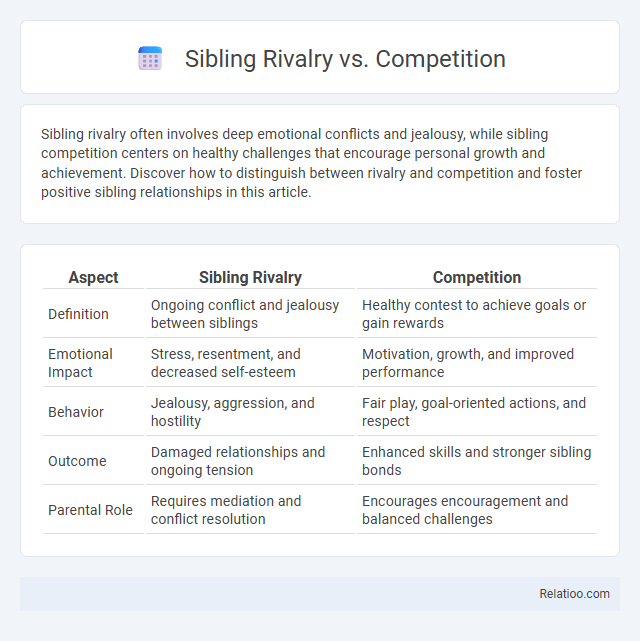Sibling rivalry often involves deep emotional conflicts and jealousy, while sibling competition centers on healthy challenges that encourage personal growth and achievement. Discover how to distinguish between rivalry and competition and foster positive sibling relationships in this article.
Table of Comparison
| Aspect | Sibling Rivalry | Competition |
|---|---|---|
| Definition | Ongoing conflict and jealousy between siblings | Healthy contest to achieve goals or gain rewards |
| Emotional Impact | Stress, resentment, and decreased self-esteem | Motivation, growth, and improved performance |
| Behavior | Jealousy, aggression, and hostility | Fair play, goal-oriented actions, and respect |
| Outcome | Damaged relationships and ongoing tension | Enhanced skills and stronger sibling bonds |
| Parental Role | Requires mediation and conflict resolution | Encourages encouragement and balanced challenges |
Understanding Sibling Rivalry: Definition and Causes
Sibling rivalry refers to the emotional and behavioral conflict between brothers and sisters, often stemming from jealousy, attention-seeking, or rivalry for parental affection. Competition among siblings differs as it can be constructive, motivating individuals to achieve personal goals without necessarily causing emotional distress. Understanding the root causes of sibling rivalry involves recognizing factors such as age gaps, parenting styles, and individual temperament, which contribute to the intensity and frequency of conflicts.
Healthy Competition Among Siblings: What It Means
Healthy competition among siblings fosters personal growth by encouraging each child to develop unique skills and strengths without resentment. It promotes motivation, inspires goal-setting, and nurtures mutual respect while avoiding the negative impacts of sibling rivalry, such as jealousy or hostility. You can strengthen family bonds by facilitating an environment where competition supports collaboration and positive reinforcement.
Differences Between Rivalry and Competition
Sibling rivalry involves ongoing emotional tension and jealousy typically rooted in feelings of inadequacy or parental favoritism, whereas sibling competition is characterized by challenges or contests that can promote growth and skill development. Rivalry tends to involve deeper personal conflicts and long-lasting resentment, while competition is often temporary and can encourage motivation and achievement between siblings. Understanding these differences helps in addressing familial dynamics effectively and fostering healthy sibling relationships.
Psychological Impact on Children
Sibling rivalry often creates emotional tension and insecurity, negatively affecting children's self-esteem and social development. In contrast, healthy sibling competition can motivate children to improve skills and foster confidence without damaging relationships. Understanding these dynamics helps you support your children's psychological well-being by promoting constructive interactions and minimizing harmful rivalry behaviors.
Common Triggers of Sibling Rivalry
Common triggers of sibling rivalry include parental favoritism, unequal attention, and competition for resources such as toys, space, or approval. Differences in personality, age gaps, and birth order can intensify conflicts, while comparisons by parents or caregivers often fuel feelings of jealousy or resentment. Understanding these triggers helps you manage and reduce tension between siblings, fostering healthier relationships and improving family dynamics.
Signs of Unhealthy Competition
Signs of unhealthy competition among siblings include constant comparison, frequent conflicts, and lack of cooperation, leading to emotional distress and strained relationships. When rivalry escalates beyond playful competition, it often manifests as jealousy, resentment, and attempts to undermine each other's achievements. Recognizing these signs early helps parents foster a supportive environment that promotes healthy interactions and mutual respect.
Strategies to Manage Rivalry at Home
Managing sibling rivalry at home requires clear communication, consistent rules, and individual attention to each child's needs to reduce conflicts. Strategies such as encouraging cooperative activities, setting boundaries for respectful behavior, and recognizing each child's unique strengths help transform rivalry into healthy competition. You can foster a supportive environment by modeling conflict resolution and reinforcing positive interactions to promote lasting sibling harmony.
Fostering Positive Competition Among Siblings
Fostering positive competition among siblings enhances their motivation, cooperation, and social skills by emphasizing shared goals and mutual support rather than conflict. Differentiating sibling rivalry, which often involves resentment and jealousy, from healthy competition helps parents create an environment where children learn from challenges and celebrate each other's successes. Encouraging fair play, recognizing individual strengths, and setting realistic expectations contribute to transforming competitive interactions into opportunities for growth and bonding.
Long-term Effects on Family Dynamics
Sibling rivalry often leads to deep-rooted resentment and strained family relationships, impacting emotional bonds over time. Sibling competition can foster motivation and individual growth but may also create persistent tension if not managed constructively. In contrast, healthy sibling cooperation encourages positive interactions, strengthening family cohesion and emotional support throughout life.
Parental Roles in Guiding Sibling Relationships
Parental roles in guiding sibling relationships are crucial in moderating sibling rivalry and competition by fostering empathy, communication, and fair conflict resolution strategies. Effective parents establish clear boundaries, model cooperative behaviors, and provide consistent emotional support to reduce antagonism and cultivate mutual respect among siblings. Understanding the distinctions between rivalry and healthy competition allows parents to encourage constructive interactions that promote individual growth and family harmony.

Infographic: Sibling Rivalry vs Competition
 relatioo.com
relatioo.com